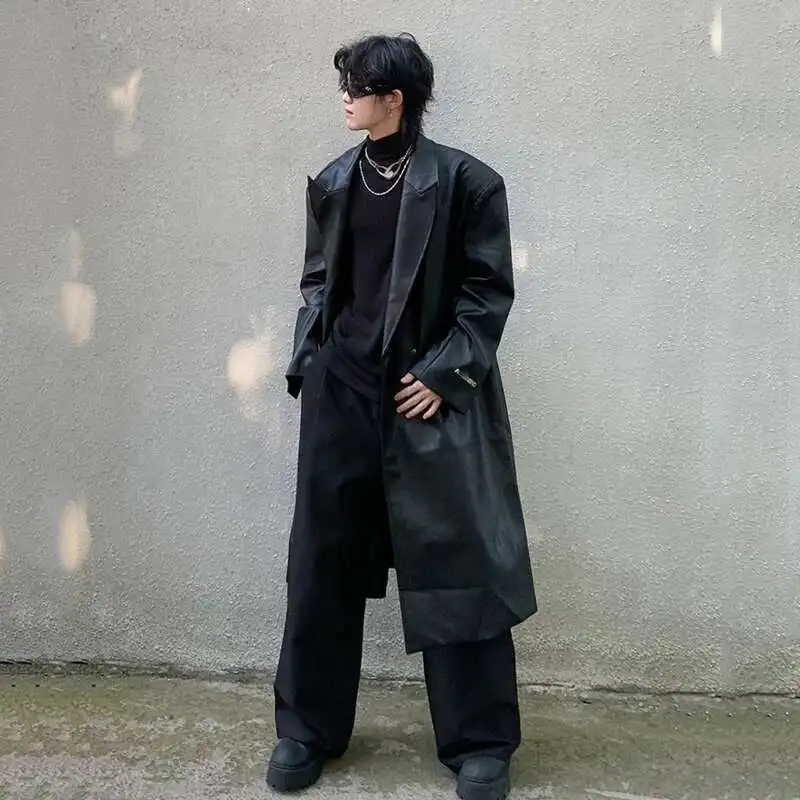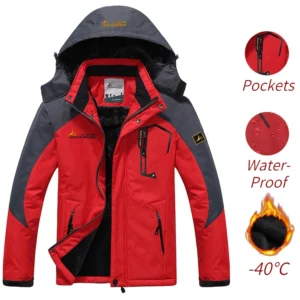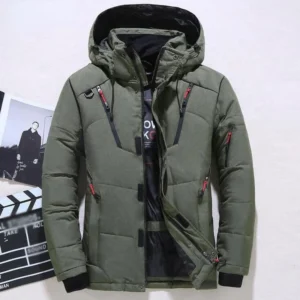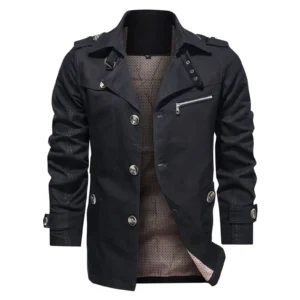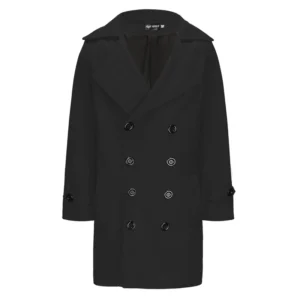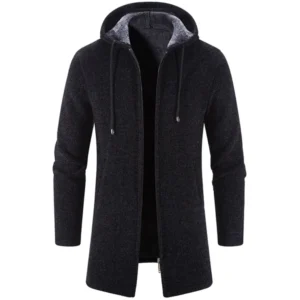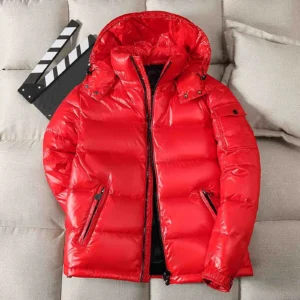Introduction: The Timeless Appeal of the Pea Coat
Few garments in men’s fashion boast the enduring appeal and versatility of the pea coat. Originally designed for naval officers braving harsh sea conditions, this military staple has seamlessly transitioned into civilian wardrobes without losing its commanding presence. The pea coat’s journey from functional maritime wear to fashion essential speaks to its perfect balance of form and function.
What makes the pea coat so perpetually relevant is its remarkable ability to elevate virtually any outfit. Its structured silhouette, distinctive double-breasted front, and robust construction instantly add polish to even the most casual ensembles. Unlike trend-focused pieces that quickly feel dated, a quality pea coat represents a smart investment that continues delivering style returns season after season.
In this comprehensive guide, we’ll explore everything from choosing the right coat length for your body type to mastering sophisticated layering techniques. Whether you’re dressing for a casual weekend or a business meeting, the pea coat’s adaptability makes it an indispensable cornerstone of the well-dressed man’s wardrobe.
Understanding the Classic Pea Coat: Key Features to Look For
Before diving into styling options, it’s important to recognize what makes an authentic pea coat stand out from other outerwear pieces. The distinctive characteristics of a traditional pea coat contribute to both its functionality and timeless aesthetic appeal.
Key features that define a genuine pea coat include:
- Double-breasted front: Featuring 6-10 buttons (typically 8) arranged in pairs, often with anchor emblems as a nod to naval heritage
- Broad, notched lapels: Usually with an Ulster collar design that can be turned up against the elements
- Heavy wool construction: Traditional pea coats use Melton wool (24-32 oz weight) for exceptional warmth and wind resistance
- Hip-length cut: Typically ending just below the hip with a straight, slightly boxy silhouette
- Functional pockets: Featuring vertical or slanted welt pockets designed for both warmth and practicality
These elements weren’t merely decorative—each served a practical purpose for seafaring men. Today, these same features make the pea coat exceptionally versatile for modern wardrobes. The substantial wool construction provides remarkable insulation while maintaining a clean, structured appearance that dresses up easily.
When investing in a quality pea coat, these traditional elements remain crucial considerations. The traditional double-breasted pea coat design has remained largely unchanged for generations because its form perfectly follows its function.
Finding Your Perfect Fit: How a Pea Coat Should Wear
The transformative power of a pea coat hinges significantly on proper fit. Even the finest wool and craftsmanship can’t compensate for improper sizing. Here’s how to ensure your pea coat enhances rather than hinders your appearance:
- Shoulders: The seam should align with your natural shoulder edge, allowing enough room for light layering without excessive fabric or padding extending beyond your actual shoulders
- Chest: When buttoned, the coat should close comfortably without pulling or creating an “X” shape across the chest
- Sleeve length: Ideally hitting at your wrist bone or the base of your thumb, allowing about ¼ inch of shirt cuff to show when arms are at rest
- Overall length: Traditional pea coats follow proper coat length guidelines by ending at mid-hip or just below—too short appears trendy but sacrifices warmth, while too long can overwhelm smaller frames
For broader or athletic builds, ensure the coat doesn’t pull across the back when crossing your arms. Those with slimmer frames should avoid excessively boxy cuts that create too much room in the torso. The right fit should feel slightly snug but never restrictive, allowing for a light sweater underneath without compromising mobility.
Remember that proper tailoring can transform an almost-right pea coat into the perfect one. Minor sleeve shortening or waist suppression can make a significant difference in how the coat frames your physique.
Choosing Your Color: Classic Hues and Their Styling Potential
While the design of a pea coat remains relatively consistent, color choice significantly impacts versatility and styling options. Each shade offers distinct advantages:
Navy Blue: The quintessential pea coat color, navy’s maritime heritage makes it exceptionally versatile. This deep blue pairs effortlessly with virtually everything in your wardrobe—from jeans and chinos to dress trousers in any color. Navy creates a classic, timeless look that works across all settings from casual to formal.
Black: For those preferring sharper, more contemporary styling, black delivers unmatched urban sophistication. While slightly less versatile than navy during daylight hours, black pea coats excel in evening wear and more formal settings. They pair beautifully with monochromatic outfits and create striking contrasts with lighter-colored trousers.
Charcoal/Grey: Offering exceptional versatility with a softer approach than black, charcoal pea coats bridge the gap between formal and casual contexts. Grey works beautifully with both cool and warm color palettes, making it particularly suitable for men with diverse wardrobes.
Less common but worth considering are camel, olive green, and burgundy wool pea coat options for those seeking distinctive alternatives while maintaining reasonable versatility. These colors make excellent second pea coats after establishing a foundational navy or charcoal option.
Casual Pea Coat Outfits: Effortless Everyday Style
The pea coat’s structured silhouette brings instant polish to casual attire without feeling overdressed. Here’s how to master everyday pea coat styling:
With Jeans: Perhaps the most natural pairing, jeans and pea coats create an effortless balance of rugged and refined. For a classic combination, pair a navy pea coat with dark indigo jeans and brown leather boots. Light wash denim creates a more relaxed weekend look, while black jeans under a black pea coat deliver sleek urban minimalism.
With Casual Trousers: Chinos in khaki, olive, or burgundy offer slightly more polish than denim while maintaining casual comfort. Corduroys add wonderful textural interest, especially in earth tones that complement the rich wool of your coat. Consider weight and fabric—heavier twills and textured cotton maintain proportional balance with the substantial coat.
Casual Tops & Layering Pieces:
– Simple crew neck t-shirts or henleys provide clean foundations
– Casual button-downs in oxford cloth, flannel, or chambray add visual interest
– Crewneck sweaters or lightweight hoodies offer perfect insulation
– Quarter-zip pullovers provide a sporty yet put-together middle layer
Footwear Choices: The right shoes balance the coat’s substantial presence while supporting the casual context:
– Clean leather sneakers in white or earth tones for modern, relaxed styling
– Leather chukkas or desert boots for versatile smart-casual appeal
– Work boots or rugged hikers for practical winter wear
– Chelsea boots for effortless style that works across dress codes
Selecting the perfect coat length for your height ensures proper proportions—taller men can typically wear slightly longer styles while shorter men benefit from coats hitting at the upper hip.
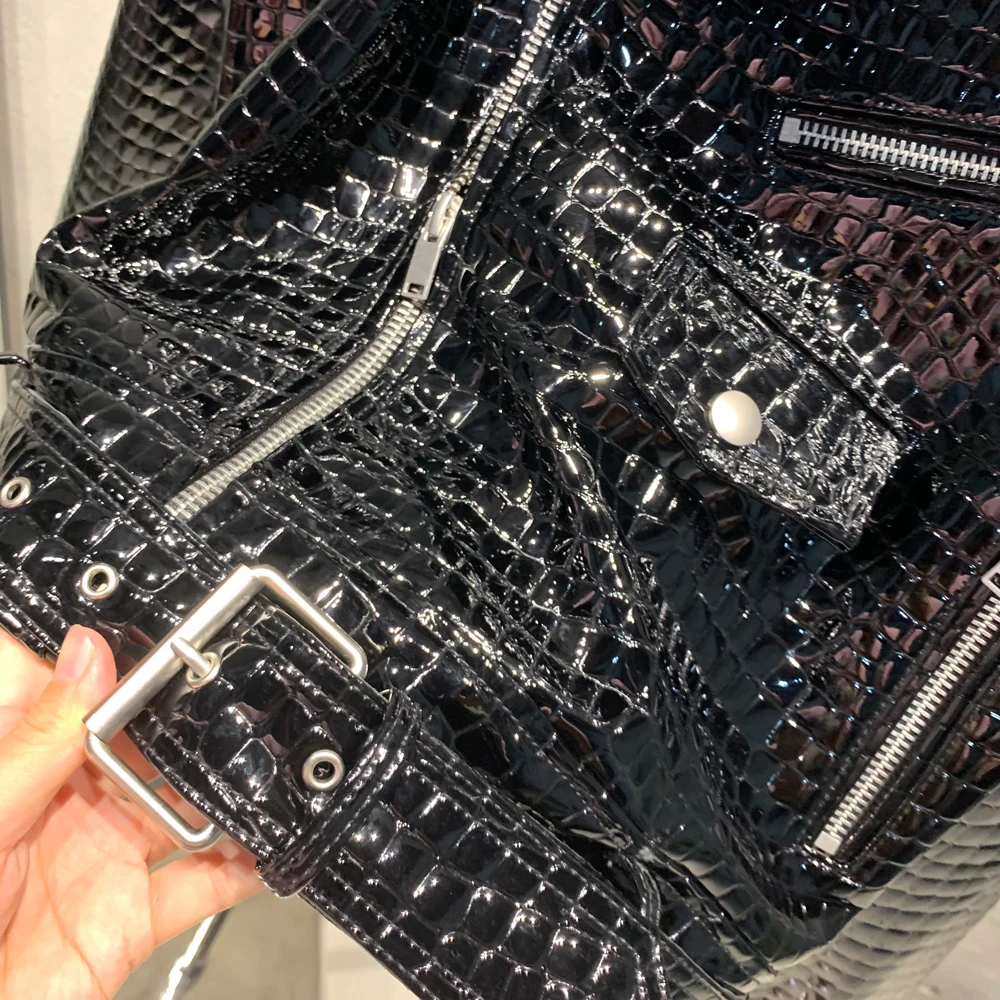
Smart-Casual Combinations: Elevating Your Pea Coat Game
The pea coat truly shines in smart-casual territory, where its structured military heritage creates perfect balance with refined casual pieces. These combinations walk the line between polished and relaxed:
Premium Denim with Fine Knitwear: Elevate dark, well-fitted jeans with a merino crew neck or turtleneck sweater beneath your pea coat. This creates a sophisticated silhouette without venturing into formal territory. Complete with leather Chelsea boots or quality brogues.
Tailored Chinos and Oxford Shirts: The clean lines of pressed chinos in neutral tones complement the pea coat’s structured form. Layer with an oxford button-down in white, pale blue, or subtle patterns, adding a merino wool v-neck for warmth if needed. Leather loafers or desert boots complete this versatile outfit.
Textured Wool Trousers and Fine Sweaters: For maximum sophistication while maintaining comfort, pair flannel or lightweight wool trousers with a cashmere sweater. This combination works beautifully for elevated weekend activities or creative professional environments.
Essential Smart-Casual Accessories:
– Knit or lightweight wool scarves in complementary colors
– Leather gloves in brown or black depending on your coat color
– Simple leather watch with metal or leather band
– Minimal leather messenger bag or briefcase
The versatility of various pea coat styles makes them ideal for these balanced ensembles that work for dinner dates, casual Friday workplaces, or weekend cultural events. The key lies in quality materials and thoughtful proportions—each element should appear intentional rather than haphazard.
Business and Semi-Formal Styling: Can a Pea Coat Work?
While traditionally considered casual to smart-casual outerwear, a well-chosen pea coat can indeed function effectively in business environments with the right approach:
Business Casual Integration: A pea coat pairs naturally with business casual staples like dress shirts, wool trousers, and blazers. The key lies in color coordination—navy and charcoal pea coats complement most business wardrobes seamlessly. Ensure your coat is slightly longer than any blazer worn underneath to maintain proper layering proportions.
Collar Considerations: When wearing a pea coat over business attire, pay careful attention to collar interactions. The pea coat’s broad lapels should frame shirt collars neatly without crushing them. With blazers, ensure the inner lapels don’t compete awkwardly with the pea coat’s collar structure.
Appropriate Business Contexts: The pea coat works best in modern office environments with relaxed dress codes or creative industries. For traditional corporate settings, reserve it for commuting or consider a longer overcoat for the most formal situations.
Complementary Footwear and Accessories:
– Cap-toe oxfords or quality derbies in colors matching your coat’s buttons
– Leather portfolio or slim briefcase rather than casual messenger styles
– Simple patterned scarves that echo colors from your business attire
– Minimal leather gloves without casual details like contrast stitching
Understanding professional wool coat styling for business settings helps strike the right balance between function and formality. Remember that in highly traditional environments, the pea coat should primarily serve as commuting wear rather than part of the in-office ensemble.
Masterful Layering: Getting the Most from Your Pea Coat
Strategic layering transforms your pea coat from a simple outer shell to a versatile piece for various weather conditions. The key lies in building functional layers without creating excessive bulk:
Light Layering: For mild temperatures (45-55°F/7-13°C), a quality t-shirt or light button-down provides sufficient insulation. This approach showcases the coat’s clean lines while maintaining comfort in transitional weather. Cotton or merino base layers work perfectly here.
Medium Layering: As temperatures drop (35-45°F/2-7°C), add a lightweight sweater, cardigan, or vest between your shirt and pea coat. This creates effective insulation while maintaining a streamlined profile. Look for thinner knits in merino wool or fine cotton that add warmth without bulk.
Heavy Layering: For genuine winter conditions (below 35°F/2°C), employ the technical approach of multiple thin layers rather than one thick one. Start with a heat-retaining base layer, add a light shirt, then a sweater, and possibly a very thin quilted vest before your pea coat. This system traps multiple pockets of warm air while allowing removal of layers as needed.
Collar Management: Master the interaction between your pea coat collar and inner layers. For maximum warmth, pair a crewneck sweater with an upturned pea coat collar. When wearing a collared shirt, ensure it sits neatly under the coat’s lapels without bunching.
Selecting the right coat length for winter layering ensures your pea coat can accommodate these multiple layers while maintaining its flattering shape. The coat should still button comfortably over your heaviest planned layering combination.
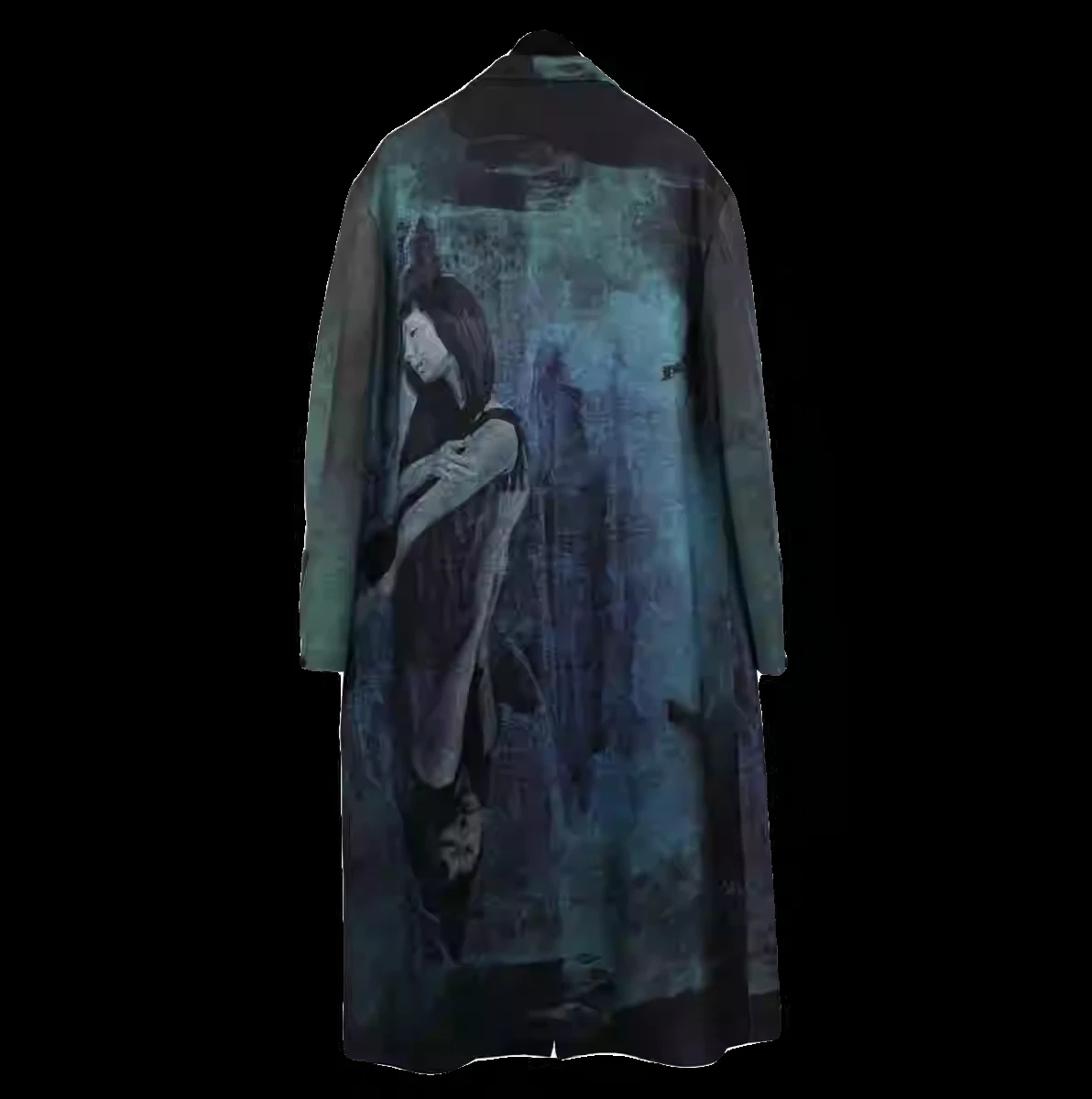
Seasonal Adaptations: Styling Your Pea Coat Year-Round
While traditionally considered winter outerwear, a pea coat can serve you through multiple seasons with thoughtful styling adjustments:
Winter Optimization: In the coldest months, your pea coat becomes a primary defense against the elements. Maximize its effectiveness by pairing with thermal base layers, thick sweaters, and winter accessories like wool scarves and insulated gloves. Consider winter pea coat guidelines for optimal performance in truly cold conditions.
Early Spring/Late Fall Transitions: As temperatures fluctuate, adapt by reducing underlying layers. A light sweater or shirt alone under your pea coat provides perfect insulation for 45-60°F (7-15°C) weather. Keep gloves and a light scarf accessible for unexpected temperature drops.
Mild Weather Evening Wear: Even during milder seasons, evenings often bring cooler temperatures. A pea coat over a simple t-shirt or light button-down offers perfect protection for spring and fall evenings without overheating. This approach works particularly well in coastal areas with significant day-to-night temperature shifts.
Adaptation Tips:
– Roll or push up sleeves of underlying layers when moving indoors
– Opt for breathable natural fibers in transitional seasons
– Unbutton the coat but keep it on indoors during brief visits to shops or restaurants
– Consider lighter-weight pea coat options (under 24 oz wool) for greater seasonal flexibility
These seasonal adaptations extend your pea coat’s utility far beyond the traditional winter months, maximizing the return on your investment in quality outerwear.
Mens Heavy Winter Coat, Mens Insulated Coat, Mens Parka Coat
Price range: $175.52 through $237.36 Select options This product has multiple variants. The options may be chosen on the product pageMens Big and Tall Winter Coats, Mens Down Coat, Mens Hooded Winter Coat, Mens Puffer Coat
Price range: $126.44 through $217.01 Select options This product has multiple variants. The options may be chosen on the product pageMens Big and Tall Winter Coats, Mens Hooded Winter Coat
Price range: $80.32 through $106.68 Select options This product has multiple variants. The options may be chosen on the product pageMens Double Breasted Pea Coat, Mens Wool Blend Coat, Mens Wool Pea Coat
Price range: $136.84 through $157.36 Select options This product has multiple variants. The options may be chosen on the product pageMens Cashmere Overcoat, Mens Hooded Winter Coat, Mens Wool Blend Coat
Price range: $128.72 through $139.68 Select options This product has multiple variants. The options may be chosen on the product pageMens Hooded Winter Coat, Mens Insulated Coat, Mens Puffer Coat, Mens Quilted Coat
Price range: $139.88 through $177.72 Select options This product has multiple variants. The options may be chosen on the product page
Essential Accessories: Completing Your Pea Coat Outfit
The right accessories not only enhance your pea coat’s style but also extend its functionality across different weather conditions:
Scarves: Perhaps the most natural pea coat companion, scarves fill the V-shaped opening at the neck while adding visual interest and warmth.
– Solid merino or cashmere in complementary colors for elegant simplicity
– Subtle patterns (herringbone, small checks) for visual texture
– Chunkier knit scarves for casual weekend styling
– Classic wrapping techniques: once around with even ends, simple drape, or the European loop
Headwear: Choose styles that complement the coat’s structured nature:
– Wool watch caps/beanies without excessive bulk for casual settings
– Classic flat caps or driving caps for smart-casual ensembles
– Felt fedoras or trilbies for more polished occasions
– Avoid baseball caps or overly sporty styles that clash with the coat’s refined character
Gloves: Select styles based on both functionality and formality:
– Smooth leather gloves (lined with cashmere or wool) for business and smart-casual wear
– Textured leather or suede for casual contexts
– Knit gloves for purely casual, relaxed settings
– Consider touchscreen-compatible options for practical modern living
Bags: Choose carriers that maintain the coat’s balanced proportions:
– Leather messenger bags or slim briefcases for business environments
– Canvas and leather combination bags for casual settings
– Structured backpacks in premium materials for practical commuting
– Avoid overly technical or sporty bags that undermine the coat’s classic aesthetic
These accessories should work together as a cohesive collection rather than competing statement pieces. Quality winter coat options paired with thoughtfully selected accessories create a complete cold-weather wardrobe system.
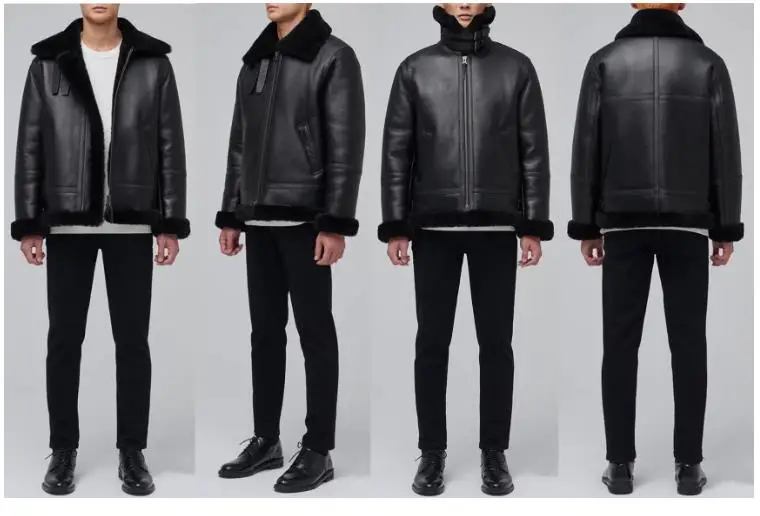
Avoiding Common Styling Mistakes: Pea Coat Do’s and Don’ts
Even quality pea coats can fall short of their potential when styling fundamentals are overlooked. Here are key guidelines to ensure your pea coat always enhances your appearance:
| Do | Don’t |
|---|---|
| Ensure underlying layers are shorter than your coat | Allow shirt tails or longer sweaters to hang below your coat hem |
| Button at least the middle buttons for proper drape | Leave your coat completely unbuttoned in cold weather |
| Match your coat’s formality to your outfit | Pair a structured pea coat with overly casual items like sweatpants or athletic wear |
| Adjust collar position based on weather and formality | Keep your collar permanently popped regardless of context |
| Choose complementary scarf colors | Add accessories that clash with your coat’s color palette |
| Maintain proper sleeve length showing ¼ inch of shirt cuff | Allow excessive shirt cuff display or completely hide your shirts |
| Select appropriate weight layers underneath | Overstuff your coat with bulky sweaters that distort its shape |
One of the most critical aspects is understanding coat length style principles to maintain proper proportions. A common mistake is choosing a pea coat that’s either too long (creating a dress-like appearance) or too short (sacrificing both warmth and classic aesthetics).
Remember that the pea coat’s military heritage embodies disciplined precision—your styling should reflect this same attention to detail. Small adjustments in fit, layering, and accessorizing make the difference between looking thrown together and thoughtfully composed.
How to Care for Your Pea Coat: Maintaining Its Appeal
A quality pea coat represents a significant investment that can deliver decades of service with proper care. These maintenance practices ensure your coat remains in excellent condition season after season:
Seasonal Storage: During warmer months, store your pea coat on a sturdy wooden hanger in a breathable garment bag. Add cedar blocks to deter moths and absorb moisture while avoiding plastic covers that can trap humidity.
Regular Maintenance: Brush your coat with a soft clothes brush after wearing to remove surface dirt and debris before it settles into the wool. Pay special attention to the collar and cuffs where oils from skin contact accumulate.
Spot Cleaning: Address small stains immediately using a damp cloth with minimal wool-safe soap, blotting rather than rubbing. Allow to air dry completely away from direct heat sources.
Professional Cleaning: Have your pea coat professionally dry cleaned only when necessary—typically once per season or when visibly soiled. Excessive cleaning can degrade the wool’s natural oils and protective qualities.
Button Care: Periodically check and tighten buttons, as their weight and frequent use can loosen threads. Keep a matching spare button in case of loss.
Drying Protocol: If your coat becomes wet, hang it to dry at room temperature away from radiators or heaters. Once nearly dry, brush gently to restore the nap of the wool.
These care practices ensure that your investment in quality wool coats pays dividends through years of impeccable appearance and performance. A well-maintained pea coat actually improves with age as the wool adapts to your body and develops a distinctive character.
Through thoughtful styling and proper care, the pea coat proves itself one of the most versatile and enduring pieces in men’s outerwear. From casual weekends to business settings, this naval-inspired classic continues to deliver unmatched style, warmth, and sophistication for the discerning modern man.

